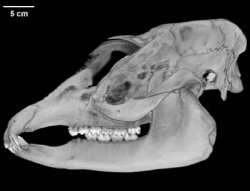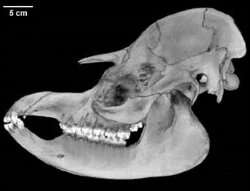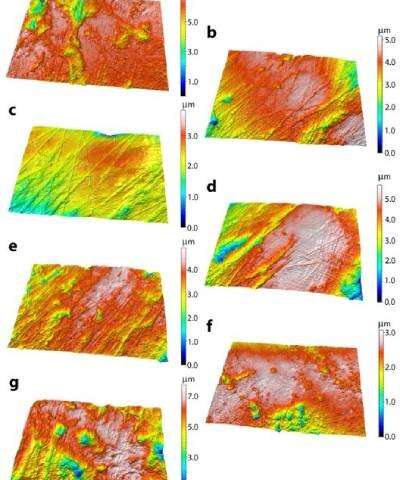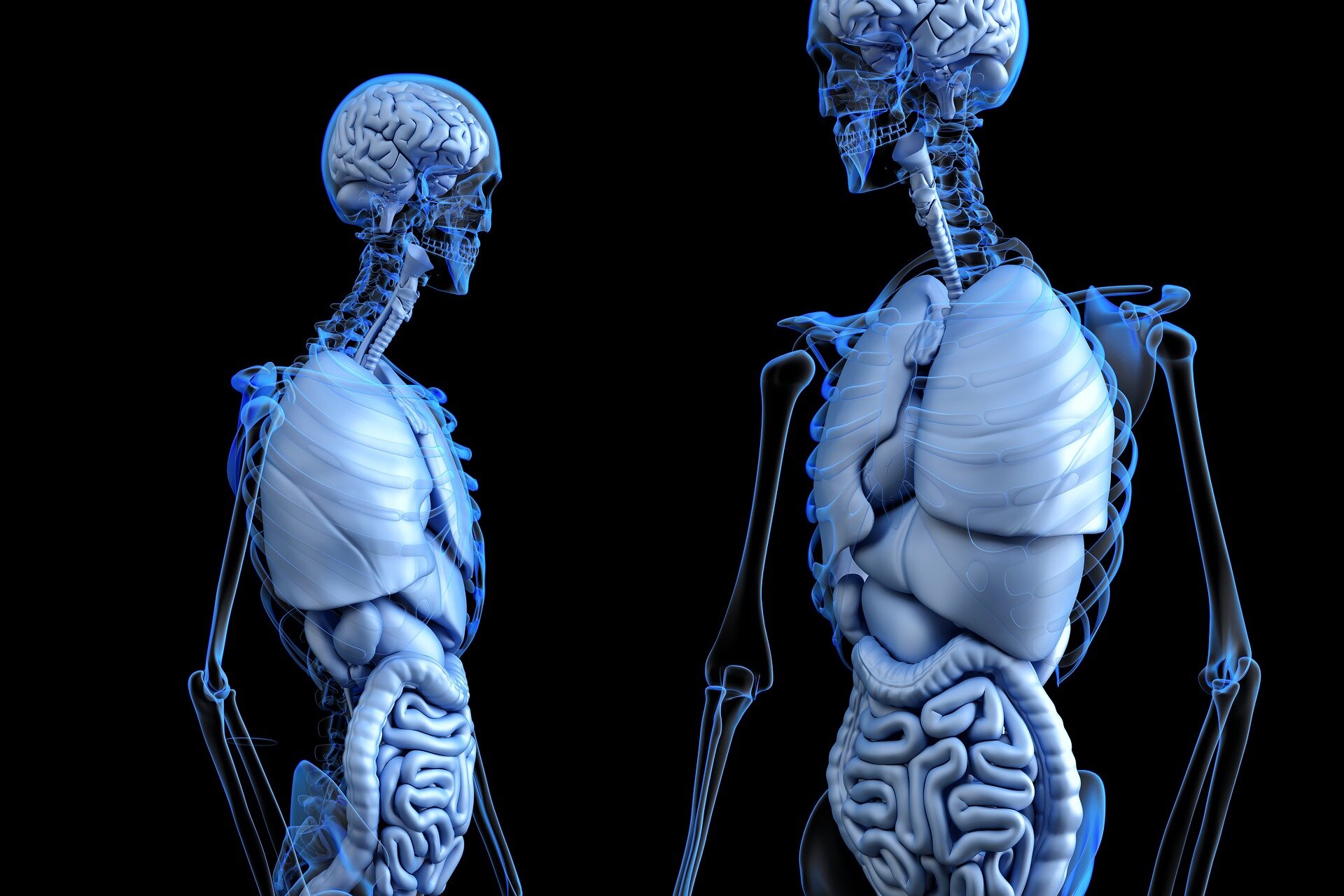#Unexpected mammal provides insight into the lives of ancient hominins
“#Unexpected mammal provides insight into the lives of ancient hominins”

For decades, anthropologists have attempted to solve the mystery of what hominins—early ancestors of humans—ate to survive. The answer to this question can be found etched into the bones and teeth of hominins, but the conclusion is not always obvious.
According to a new study published in the journal Scientific Reports, led by Larisa DeSantis, paleontologist and associate professor of biological sciences at Vanderbilt, the answer to early hominin diets may lie in an unrelated group of large herbivorous mammals—tapirs.
Some species of tapirs have large sagittal crests—bony ridges on the top of their skulls where large jaw muscles attach—which are similar to certain hominins. DeSantis’ team of researchers used finite element analysis and dental microwear texture analysis, methods typically used by engineers, to assess the stress and strain that chewing a variety of food textures inflects on different skull structures.
“Sometimes you have to think completely out of the box and rethink relationships between skull shape and function,” said DeSantis. “Our research aimed to examine if tapirs’ large sagittal crests are required for eating hard food or have other functions. We found that sagittal crests allowed for prolonged chewing of tough foods like leaves, and are not present in tapir species that eat the hardest foods.”

This study has important implications for reevaluating relationships between form and function in mammals. It reaffirms the importance of reviewing a wide spectrum of organisms when searching for clues about the behavior of extinct animals.
The research builds on published analysis of Paranthropus boisei, an early hominin often referred to as “nutcracker man.” Our ancient relatives were thought to chew and eat hard foods based on their specialized skull shape, but a microscopic look at teeth textures and chemical signatures in the teeth indicate that P. boisei did not eat hard foods like nuts, rather soft or tough food like grasses or strong, fibrous leaves and stems.
“In paleobiology, we never know where our next insights will come from,” said Mark Teaford, vice chair of the Department of Basic Science at Touro University and an author of the aforementioned analysis of P. boisei. “This study is a perfect case in point. By using state-of-the-art techniques but looking outside the usual cast of characters as models for early human ancestors, it reaffirms some ideas and provides new perspectives as well.”
The group imaged modern tapirs with known diets and a variety of tapir fossils from throughout the southeastern U.S. including the Gray Fossil Site in east Tennessee, the location of the world’s most abundant tapir fossil assemblage. The research team’s analysis found that the South America-dwelling lowland tapir with the largest sagittal crest experiences significant strain from its high-crest skull form and eats tough foods like leaves. In contrast, Baird’s tapir—a species that lives in Latin America—lacks a sagittal crest and sports the highest bite efficiencies, eating the hardest foods including palm seeds. These results demonstrate that sagittal crests in tapirs are beneficial for processing lots of tough foods and are not a requirement of hard-food eating. The research team suggests that sagittal crests in some ancient hominins may have yielded similar benefits. In particular, P. boisei may have benefited from increased muscle volume to process significant amounts of vegetation with less muscle fatigue.

“This research is particularly exciting because it involves very careful experimental observations on the feeding behavior and mechanics of the skull of a mammal that takes us beyond the limits of the familiar higher primate models that dominate studies of early fossil hominins,” noted Frederick Grine, professor and chair of the Department of Anthropology at Stony Brook University, and the paper’s co-author. “By using the tapir—an animal much more closely related to rhinos than humans—this team has opened their research into a realm that is rich with possibilities and unique insights into the dietary adaptations of our extinct cousins, the australopiths.”
“This is an incredibly imaginative and innovative study. Anthropologists have hit a bit of a stalemate in trying to understand the behavior of robust australopiths. Part of the problem is that there are no living primates with the full range of distinctive adaptations observed in this group,” said Mary Silcox, professor of anthropology at the University of Toronto Scarborough who was not connected to the study. “Looking for modern analogs in other groups is an inspired approach. The results are broadly in line with current ideas about what robust australopiths are eating. It seems increasingly likely that a skull we used to refer to as ‘nutcracker man’ might be better called ‘tough chewing man’! Not quite as evocative. But more likely to be true! The DeSantis lab stands out for its imaginative research program, and engagement with the most recent, and robust, methods for dietary reconstruction.”
Looking to other mammals for hints is essential to understanding the lives of hominins. As large sagittal crests provide room for large temporalis muscle attachments that help with chewing and jaw movement, their presence in carnivores like hyenas is often correlated with bone-crushing behavior. These large sagittal crests are also present in herbivores like giant panda bears, which primarily crack open and consume bamboo. In primates, large sagittal crests occur in apes like gorillas and orangutans, which eat a mixture of hard and tough foods and are pronounced in the largest males. Because of many complicating factors including body size, there are no perfect primate models for inferring ancient hominin diets.
More information:
Larisa R. G. DeSantis et al. Clarifying relationships between cranial form and function in tapirs, with implications for the dietary ecology of early hominins, Scientific Reports (2020). DOI: 10.1038/s41598-020-65586-w
Unexpected mammal provides insight into the lives of ancient hominins (2020, June 12)
retrieved 12 June 2020
from https://phys.org/news/2020-06-unexpected-mammal-insight-ancient-hominins.html
This document is subject to copyright. Apart from any fair dealing for the purpose of private study or research, no
part may be reproduced without the written permission. The content is provided for information purposes only.
If you want to read more Like this articles, you can visit our Science category.
if you want to watch Movies or Tv Shows go to Dizi.BuradaBiliyorum.Com for forums sites go to Forum.BuradaBiliyorum.Com


